An Improved Control Strategy of PMSM Drive System with Integrated Bidirectional DC/DC
Abstract
:1. Introduction
2. Per-Unit Model and Electrical Limitation of IPMSM
2.1. Permanent Magnet Synchronous Motor Per-Unit Model
- (1)
- Ignoring the core saturation effect, regardless of eddy current and hysteresis loss;
- (2)
- Ignoring leakage inductance of motor winding;
- (3)
- No damping winding on the rotor;
- (4)
- The permanent rotor magnet magnetic field is sinusoidally distributed in the air gap space, and the induced potential in the stator armature winding is also sinusoidally distributed.
2.2. Operating Limits of Permanent Magnet Synchronous Motor
3. The Proposed Control Method
3.1. Fixed SVPWM Modulation Index Algorithm
3.2. Voltage Command Compensation Algorithm
4. Simulation and Experimental Analysis
4.1. Simulation Results and Analysis
4.2. Experiment Results and Analysis
5. Conclusions
Author Contributions
Funding
Conflicts of Interest
References
- Ivanchev, J.; Fonseca, J.; Knoll, A. Electrification and automation of road transport: Impact analysis of heat and carbon emissions for singapore. In Proceedings of the 2020 IEEE 23rd International Conference on Intelligent Transportation Systems (ITSC), Rhodes, Greece, 20–23 September 2020; pp. 1–8. [Google Scholar]
- Ibanez, F.M.; Florez, A.M.B.; Gutiérrez, S.; Echeverrría, J.M. Extending the Autonomy of a Battery for Electric Motorcycles. IEEE Trans. Veh. Technol. 2019, 68, 3294–3305. [Google Scholar] [CrossRef]
- Pellegrino, G.; Vagati, A.; Guglielmi, P.; Boazzo, B. Performance Comparison Between Surface-Mounted and Interior PM Motor Drives for Electric Vehicle Application. IEEE Trans. Ind. Electron. 2012, 59, 803–811. [Google Scholar] [CrossRef] [Green Version]
- Sarigiannidis, A.G.; Beniakar, M.E.; Kladas, A.G. Fast Adaptive Evolutionary PM Traction Motor Optimization Based on Electric Vehicle Drive Cycle. IEEE Trans. Veh. Technol. 2017, 66, 5762–5774. [Google Scholar] [CrossRef]
- Laskaris, K.I.; Kladas, A.G. Internal Permanent Magnet Motor Design for Electric Vehicle Drive. IEEE Trans. Ind. Electron. 2010, 57, 138–145. [Google Scholar] [CrossRef]
- Wang, Y.; Li, Y.; Huang, X.; Fang, Y.; Ma, J. Comparison of direct-drive permanent-magnet synchronous motor and permanent-magnet flux-modulated motor for electric vehicles. In Proceedings of the 2017 20th International Conference on Electrical Machines and Systems (ICEMS), Sydney, NSW, Australia, 11–14 August 2017; pp. 1–5. [Google Scholar]
- Akar, F.; Tavlasoglu, Y.; Ugur, E.; Vural, B.; Aksoy, I. A Bidirectional Nonisolated Multi-Input DC–DC Converter for Hybrid Energy Storage Systems in Electric Vehicles. IEEE Trans. Veh. Technol. 2016, 65, 7944–7955. [Google Scholar] [CrossRef]
- Lin, Y.S.; Hu, K.W.; Yeh, T.H.; Liaw, C.M. An Electric-Vehicle IPMSM Drive with Interleaved Front-End DC/DC Converter. IEEE Trans. Veh. Technol. 2016, 65, 4493–4504. [Google Scholar] [CrossRef]
- Zhang, Y.; Gao, Y.; Zhou, L.; Sumner, M. A Switched-Capacitor Bidirectional DC–DC Converter with Wide Voltage Gain Range for Electric Vehicles with Hybrid Energy Sources. IEEE Trans. Power Electron. 2018, 33, 9459–9469. [Google Scholar] [CrossRef]
- Gong, C.; Hu, Y.; Wen, H.; Chen, G.; Li, W.; Gao, J. Reliable Winding-Based DC-Bus Capacitor Discharge Technique Over Full-Speed Range for IPMSM Drive in Electric Vehicles Without Position Sensor. IEEE Trans. Ind. Electron. 2020, 67, 8131–8142. [Google Scholar] [CrossRef]
- Elsayad, N.; Moradisizkoohi, H.; Mohammed, O.A. A New Hybrid Structure of a Bidirectional DC-DC Converter with High Conversion Ratios for Electric Vehicles. IEEE Trans. Veh. Technol. 2020, 69, 194–206. [Google Scholar] [CrossRef]
- Beraki, M.W.; Trovão JP, F.; Perdigão, M.S.; Dubois, M.R. Variable Inductor Based Bidirectional DC–DC Converter for Electric Vehicles. IEEE Trans. Veh. Technol. 2017, 66, 8764–8772. [Google Scholar] [CrossRef]
- Zhang, Y.; Cheng, X.F.; Yin, C.; Cheng, S. A Soft-Switching Bidirectional DC–DC Converter for the Battery Super-Capacitor Hybrid Energy Storage System. IEEE Trans. Ind. Electron. 2018, 65, 7856–7865. [Google Scholar] [CrossRef]
- Howlader, A.M.; Urasaki, N.; Senjyu, T.; Yona, A.; Saber, A.Y. Optimal PAM Control for a Buck Boost DC-DC Converter with a Wide-Speed-Range of Operation for a PMSM. J. Power Electron. 2010, 10, 477–484. [Google Scholar] [CrossRef] [Green Version]
- Yu, C.; Tamura, J.; Lorenz, R.D. Control method for calculating optimum DC bus voltage to improve drive system efficiency in variable DC bus drive systems. In Proceedings of the 2012 IEEE Energy Conversion Congress and Exposition (ECCE), Raleigh, NC, USA, 15–20 September 2012; pp. 2992–2999. [Google Scholar]
- Lemmens, J.; Driesen, J.; Vanassche, P. Dynamic DC-link voltage adaptation for thermal management of traction drives. In Proceedings of the 2013 IEEE Energy Conversion Congress and Exposition, Denver, CO, USA, 15–19 September 2013; pp. 180–187. [Google Scholar]
- Yamamoto, K. Power loss reduction and optimum modulation index of PWM inverter with voltage booster for permanent magnet synchronous motor drive. In Proceedings of the 2000 Conference Rec. IPEC, Tokyo, Japan, 3–7 April 2000; pp. 147–152. [Google Scholar]
- Chen, K.; Sun, Y.; Liu, B. Interior Permanent Magnet Synchronous Motor Linear Field-Weakening Control. IEEE Trans. Energy Conversion 2016, 31, 159–164. [Google Scholar] [CrossRef]
- Ding, D.; Wang, G.; Zhao, N.; Zhang, G.; Xu, D. Enhanced Flux-Weakening Control Method for Reduced DC-Link Capacitance IPMSM Drives. IEEE Trans. Power Electron. 2019, 34, 7788–7799. [Google Scholar] [CrossRef]
- Wang, S.; Kang, J.; Degano, M.; Galassini, A.; Gerada, C. An Accurate Wide-Speed Range Control Method of IPMSM Considering Resistive Voltage Drop and Magnetic Saturation. IEEE Trans. Ind. Electron. 2020, 67, 2630–2641. [Google Scholar] [CrossRef]
- Sepulchre, L.; Fadel, M.; Pietrzak-David, M.; Porte, G. MTPV Flux-Weakening Strategy for PMSM High Speed Drive. IEEE Trans. Ind. Appl. 2018, 54, 6081–6089. [Google Scholar] [CrossRef]
- Zhang, X.; Wang, B.; Yu, Y.; Zhang, J.; Dong, J.; Xu, D. Circular Arc Voltage Trajectory Method for Smooth Transition in Induction Motor Field-Weakening Control. IEEE Trans. Ind. Electron. 2021, 68, 3693–3706. [Google Scholar] [CrossRef]




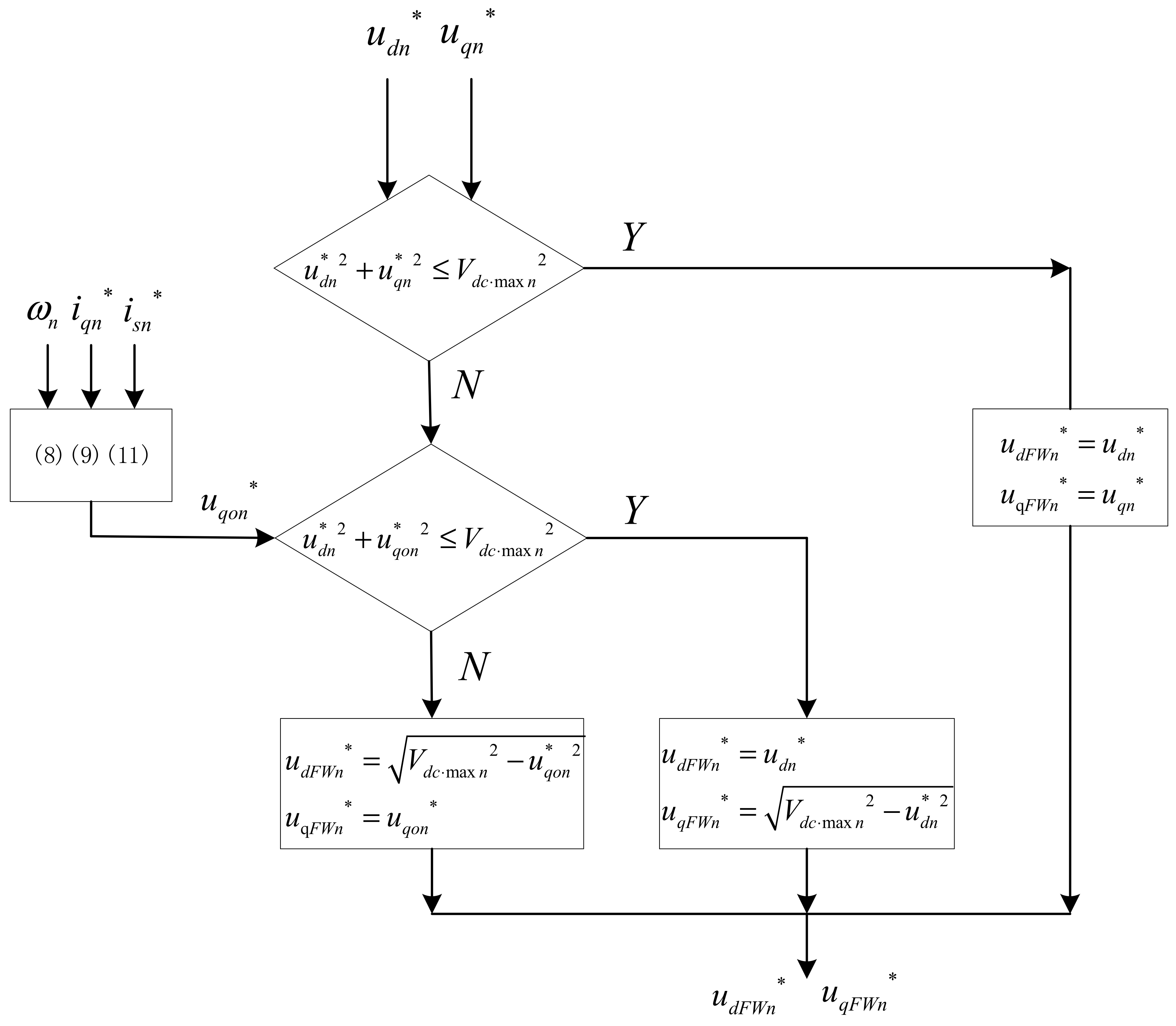
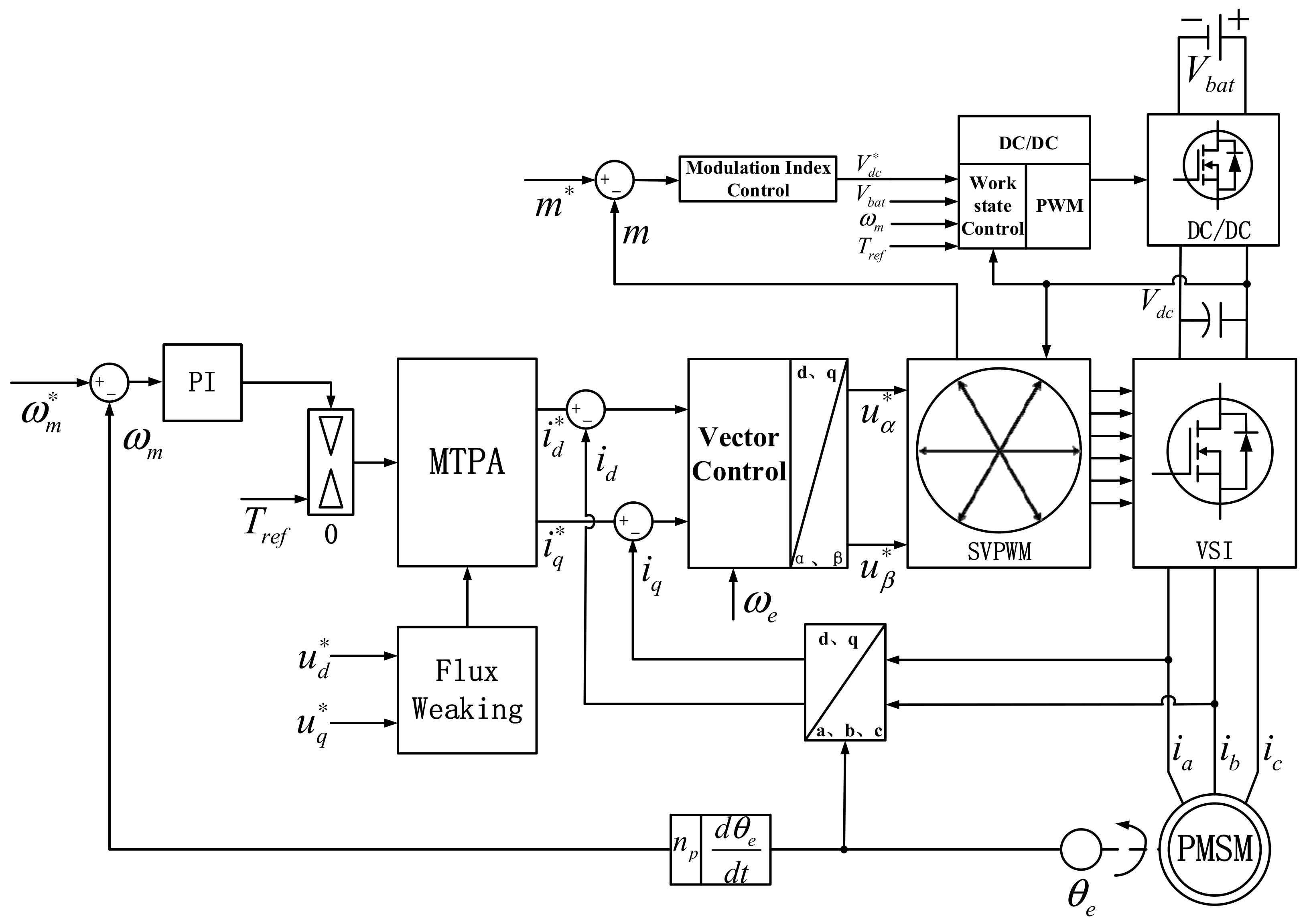

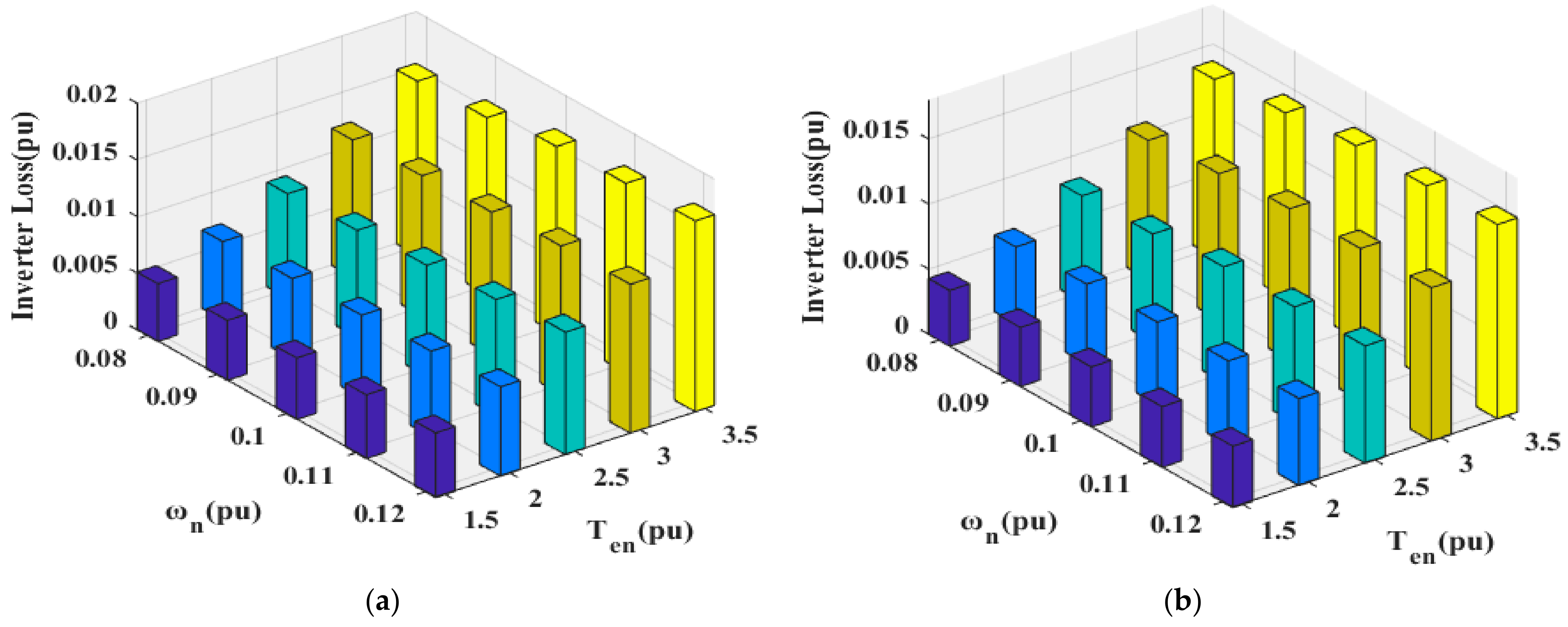
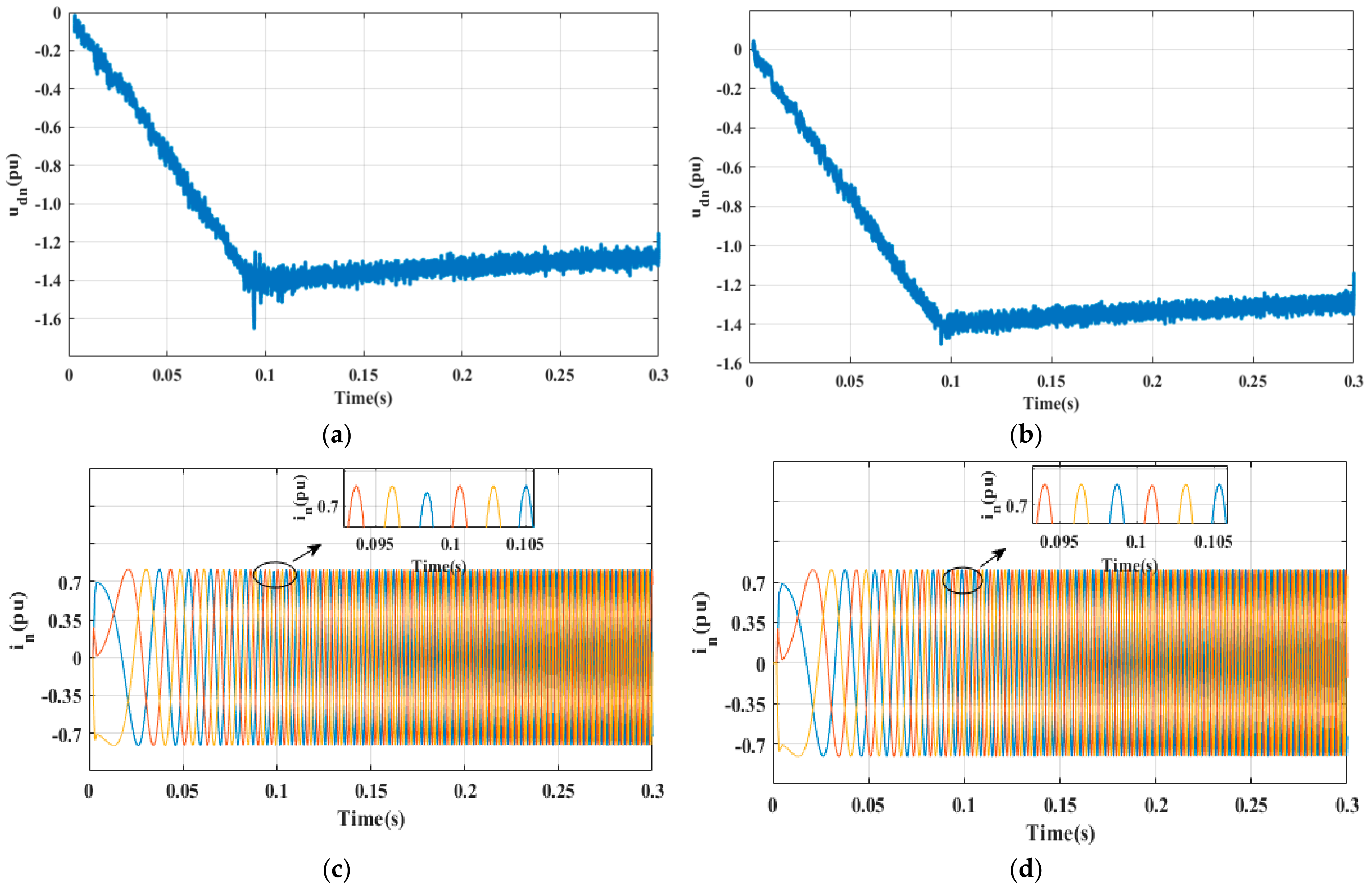

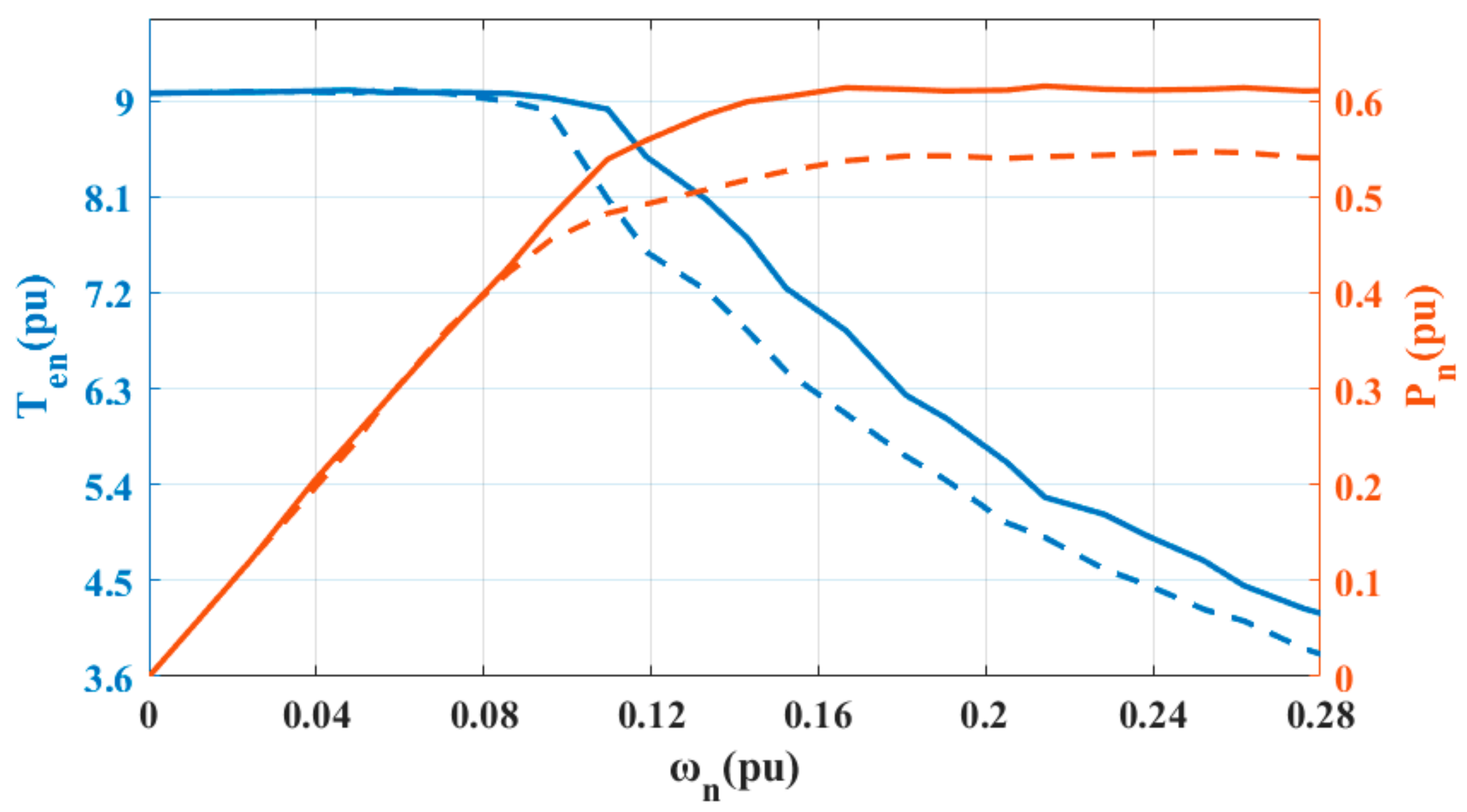


| Symbol | Quantity | PMSM |
|---|---|---|
| base flux linkage | ||
| base current | ||
| base voltage | ||
| saliency ratio |
| Parameter | Symbol | Value |
|---|---|---|
| Stator resistor | 4.614 mΩ | |
| Direct axis inductance | 85 μH | |
| Quadrature axis inductance | 178 μH | |
| Magnet flux linkage | 0.015 Wb | |
| pole pairs | 6 |
Publisher’s Note: MDPI stays neutral with regard to jurisdictional claims in published maps and institutional affiliations. |
© 2022 by the authors. Licensee MDPI, Basel, Switzerland. This article is an open access article distributed under the terms and conditions of the Creative Commons Attribution (CC BY) license (https://creativecommons.org/licenses/by/4.0/).
Share and Cite
Liu, D.; Guo, X.; Lei, Y.; Wang, R.; Chen, R.; Chen, F.; Li, Z. An Improved Control Strategy of PMSM Drive System with Integrated Bidirectional DC/DC. Energies 2022, 15, 2214. https://doi.org/10.3390/en15062214
Liu D, Guo X, Lei Y, Wang R, Chen R, Chen F, Li Z. An Improved Control Strategy of PMSM Drive System with Integrated Bidirectional DC/DC. Energies. 2022; 15(6):2214. https://doi.org/10.3390/en15062214
Chicago/Turabian StyleLiu, Dongliang, Xinhua Guo, Youjian Lei, Rongkun Wang, Ruipei Chen, Fenyu Chen, and Zhongshen Li. 2022. "An Improved Control Strategy of PMSM Drive System with Integrated Bidirectional DC/DC" Energies 15, no. 6: 2214. https://doi.org/10.3390/en15062214







